Pectus excavatum is the most frequent congenital chest wall deformity encountered in medical practice. This condition manifests as a conspicuous inward depression of the sternum and adjacent costal cartilages, creating a caved-in or funnel-shaped appearance of the chest. The complexity of this deformity necessitates a highly specialized approach to care, which is where dedicated institutions provide essential expertise. This discussion focuses on the condition itself and the advanced corrective techniques available.
The Anatomical and Physiological Impacts
The implications of pectus excavatum extend beyond cosmetic concerns. The psychological impact — including self-consciousness and reduced self-esteem — is often significant and can affect a patient’s overall well-being. In addition to these emotional impacts, moderate to severe cases may also experience physical issues, as the chest depression may compress the heart and lungs, potentially leading to measurable cardiopulmonary compromise. Individuals may experience exercise intolerance, shortness of breath, or heart palpitations. A comprehensive evaluation is therefore critical to understand the full scope of how an individual’s pectus excavatum affects their health and quality of life.
The Role of Specialized Surgical Centers
For patients requiring intervention, the Wang procedure provides a proven minimally invasive option for correcting pectus excavatum. This sophisticated technique involves the placement of a custom-fitted metal bar on the surface of the depressed bony structure to lift and reshape the chest wall. The success of such a procedure is profoundly influenced by surgical experience. Centers with a singular focus, such as The Institute of Chest Wall Surgery (ICWS), dedicate their practice to these specific deformities, offering a high degree of proficiency in evaluating and treating complex cases of pectus excavatum, with the ultimate goal of restoring both the function and contour of the patient’s chest wall.
Conclusion
In summary, pectus excavatum is a bony structural deformity with potential physical and psychological consequences. Successful treatment, particularly surgical correction, demands specialized knowledge and technical skill. Seeking evaluation from a focused center ensures access to comprehensive care tailored to the unique challenges of this chest wall deformity, providing patients with the best possible outcomes.


